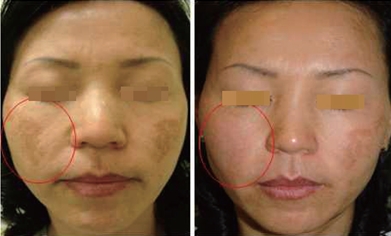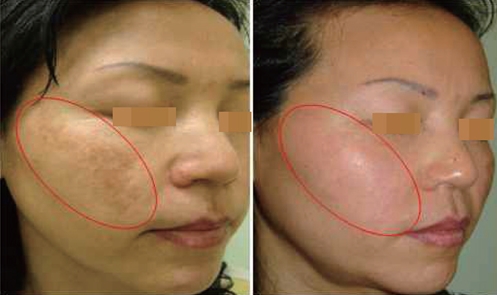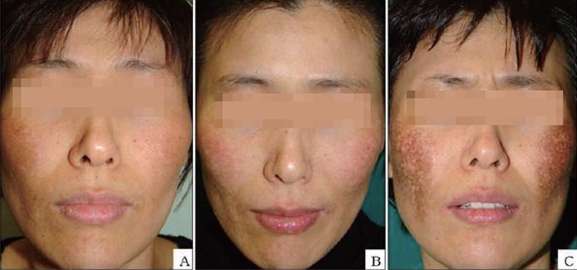▶ Previous Artlcle : #3-1. Current Laser Technology in Dermatological Field
In order to establish therapeutic concept and theory, I have conducted a clinical and histological study for the last several years using electron microscope(TEM, SEM, 3D tomography, etc) in human skin and zebra fish. The results found that, because the melanins in active melanocyte are not only present around the cell nucleus but they are also delivered to horny cells through dendrite, laser toning does not cause cell death and only damages melanins in the dendrite. A reconstructed 3-dimensional image also confirmed the removal of melanins mostly at the junctions between melanocyte dendrite and horny cell.
[Advertisement] Tulip(Skin Tightening & Lifting) – Manufacturer: DANIL SMC(www.danilsmc.com)
This study established the mechanism and concept of laser toning, by confirming that low energy level damages not melanocytes but only the melanosomes present in the dendrite, where mostly stage IV melanosomes are gathered.
Further studies are needed to develop a new procedure using this concept. For example, individualized therapeutic devices and methods depending on the skin type and the degree of hyperpigmentation, and agents or inhibitors for maintaining the clinical effect after laser therapy, should be developed.

Before and after laser toning
A. Before, B. After 7th LT

Before and after laser toning
A. Pretx, B. After 7th LT
The fourth is Extended Theory of SP (ESP) technology.
When the energy cannot be delivered directly to a target chromophore, adjacent chromophores can be gradually heated with photothermal energy, until the heat could be delivered to the target by heat diffusion enough to damage the target. This technology has become the basic theory for hair removal; enough heat applied to hair pigment with a long pulse duration can be delivered to an adjacent biological target. However, long external heat application required a cooling technology to minimize epidermal damage, which is why this technology has been developed only recently as an effective method for permanent hair removal with the advent of cooling system.

Dyspigmentation from excessive stimulation with high energy
Lastly, I’d like to share my opinion about the future of laser development with you. Recent introduction of laser for scar treatment has led to a fundamental change in scar treatment from complete dependence on surgery in the past. Unlike in the past, various types of laser therapies are being attempted for scars, especially those sustained within past 6 months. In order to correct excessive neovascularization and abnormal collagen remodeling in the course of wound healing process before developing to a hypertrophic scar, various laser therapies have been attempted for each time period a lot of them have been scientifically proved for their effectiveness. Most of all, fractional CO2 laser has become a very effective measure for burn scars, for which there was no particular treatment in the past.
There are a lot of technologies currently under development or to be developed in the future, and one of them is to create an opening with Er:YAG laser and deliver a drug that is difficult to apply or stem cells, by means of Trans Dermal Delivery. This method is expected to yield a superior rejuvenation effect, because Long Pulsed 1320nm irradiated to the dermis, while avoiding epidermis, may produce a more effective dermal regeneration effect.
With the development of a device that can adjust the energy output according to the amount of melanin in the skin per race and per skin type, it would be also possible to develop a more individualized therapeutic technology, which may be available by redeeming some shortcomings of existing products.
In the future, a technology to inhibit laser-induced inflammation with antioxidant and lasers specialized for particular tissues, such as sebaceous gland, sweat gland and nail will be promising.
References
1. Anderson RR, Margolis RJ, Watenabe S, Flotte T, Hruza GJ, Dover JS. Selective photothermolysis of cutaneous pigmentation by Q-switched Nd: YAG laser pulses at 1064, 532, and 355 nm. J Invest Dermatol. 1989 Jul;93(1):28-32.
2. Alexiades-Armenakas MR, Dover JS, Arndt KA. The spectrum of laser skin resurfacing: nonablative, fractional, and ablative laser resurfacing. J Am Acad Dermatol. 2008 May;58(5):719-37.
3. Jeong SY, Chang SE, Choi JH, Kim IH. New Melasma Treatment by Collimated Low Fluence Q-switched Nd:YAG Laser. Korean J Dermatol 2008;46(9):1163.1170
4. Kim JH, Kim H, Park HC, Kim IH. Subcellular selective photothermolysis of melanosomes in adult zebrafish skin following 1064-nm Q-switched Nd:YAG laser irradiation. J Invest Dermatol. 2010 Sep;130(9):2333-5.
5. JY Mun, SY Jeong, JH Kim, SS Han & Il-Hwan Kim, 『A low fluence Q-switched Nd:YAG laser modifies the 3Dstructure of melanocyte and ultrastructure of melanosome by subcellular-selective photothermolysis』Journal of Electron Microscopy 60(1):11–18, 2011.
6. Grunewald S, Bodendorf MO, Simon JC, Paasch U. Update dermatologic laser therapy. J Dtsch Dermatol Ges. 2011 Feb;9(2):146-59.
7. Altshuler GB, Anderson RR, Manstein D, Zenzie HH, Smirnov MZ. Extended theory of selective photothermolysis. Lasers Surg Med. 2001;29(5):416-32.
8. Manstein D, Herron GS, Sink RK, Tanner H, Anderson RR. Fractional photothermolysis: a new concept for cutaneous remodeling using microscopic patterns of thermal injury. Lasers Surg Med. 2004;34(5):426-38.
9. Kent KM, Graber EM. Laser tattoo removal: a review. Dermatol Surg. 2012 Jan;38(1):1-13.
-The end-





















